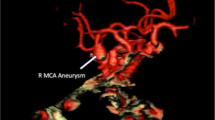Abstract
Cerebral vasospasm is a clinical/angiographical condition frequently observed after a subarachnoid hemorrhage due to the rupture of an intracranial aneurysm. Twenty cases of vasospasm observed after the removal of cerebral tumors have been reported in the literature; we here report on a further five. The time of onset of symptomatic vasospasm was 3–7 days after surgery; three of the patients died of an ischemic event induced by the vasospasm and two survive. Although no angiographic confirmation was obtained in our cases, serial transcranial Doppler (TCD) flow velocities were always high. It is suggested that the TCD-revealed accumulation of blood in the basal cisterns observed in all cases may have been responsible for this unusual condition, and it is therefore important to consider vasospasm as a probable etiological cause of clinical deterioration in patients undergoing the surgical removal of a cerebral tumor. For this reason, whenever any neurological deterioration occurs in such patients, it is advisable to perform TCD in order to verify the presence of any vasospasm and promptly commence suitable treatment.
Sommario
Il vasospasmo cerebrale è una condizione clinico-angiografica che si osserva frequentemente dopo una emorragia subaracnoidea da rottura di un aneurisma intracranico. L'osservazione del vasospasmo dopo l'exeresi di un tumore cerebrale è riportato in letteratura in 20 casi. Segnaliamo 5 nuovi casi di vasospasmo verificatisi dopo l'asportazione di un tumore cerebrale, trattandone gli aspetti patogenetici. A nostro avviso è importante considerare il vasospasmo come probabile causa eziologica di deterioramento clinico nei pazienti sottoposti ad intervento chirurgico di rimozione di un tumore cerebrale. Per tale motivo, nei pazienti operati per tumore cerebrale che presentino un deterioramento dello stato neurologico, è consigliabile l'esecuzione di un doppler transcranico, al fine di rilevare l'eventuale presenza di vasospasmo cerebrale ed instaurare prontamente la terapia adeguata.
Similar content being viewed by others
References
Adams C.B.T.:Vasospasm: occurrence in conditions other than subarachnoid hemorrhage from a bleeding aneurysm. In: Wilkins R.H. (Ed.), Cerebral arterial spasm, Baltimore, Williams & Wilkins, 471, 1980.
Aoki N., Origitano T.C., Al-Mefty O.:Vasospasm after resection of skull base tumors. Acta Neurochir., 132: 53–58, 1995.
Brau R.H., Lameiro J., Llaguno A.V., Rifkinson N.:Metamorphopsia and permanent cortical blindness after a posterior fossa tumor. Neurosurgery, 19: 263–266, 1986.
Boullin D.J., Tagari P., Du Boulay G. et al.:The role of hemoglobin in the etiology of cerebral vasospasm. An in vivo study of baboons. J. Neurosurg., 59: 231–236, 1983.
Camp P.E., Paxton H.D., Buchan G.C., Gahbauer H.:Vasospasm after trans-sphenoidal hypophysectomy. Neurosurgery, 7: 382–386, 1980.
de Almeida G.M., Bianco E., Souza A.S.:Vasospasm after acoustic neuroma removal. Surg. Neurol., 23: 38–40, 1985.
Krayenbuhl H.:Beitrag zur Frage des cerebralen angiospastichen insultes. Schweiz Med Wochenschr., 90: 961–965, 1960.
LeRoux P.D., Haglund M.M., Mayberg M.R., Winn H.R.:Symptomatic cerebral vasospasm following tumor resection: report of two cases. Surg. Neurol., 36: 25–31, 1991.
Martin N.A., Doberstein C., Zane C. et al.:Post-traumatic cerebral arterial spasm: transcranial doppler ultrasound, cerebral blood flow, and angiographic findings. J. Neurosurg., 77: 575–583, 1992.
Mawk J.R., Ausman J.I., Erickson D.L., Maxwell R.E.:Vasospasm following transcranial removal of large pituitary adenomas: report of three cases. J. Neurosurg., 50: 229–232, 1979.
Peerless S.J.:Postoperative cerebral vasospasm without subarachnoid hemorrhage. In: Wilkins R.H. (Ed.), Cerebral arterial spasm. Baltimore, Williams & Wilkins, 496–498, 1980.
Sekhar L.N., Wechsler L.R., Yonas H.R. et al.:Value of TCD examination in the diagnosis of cerebral vasospasm after subarachnoid hemorrhage. Neurosurgery, 22: 813–821, 1988.
Wilkins R.H.:Hypothalamic dysfunction and intracranial arterial spasm. Surg. Neurol., 4: 472–480, 1975.
Author information
Authors and Affiliations
Rights and permissions
About this article
Cite this article
Cervoni, L., Salvati, M. & Santoro, A. Vasospasm following tumor removal: report of 5 cases. Ital J Neuro Sci 17, 291–294 (1996). https://doi.org/10.1007/BF01997789
Received:
Accepted:
Issue Date:
DOI: https://doi.org/10.1007/BF01997789




